Samsung The Serif Review
The TV that ties the room together
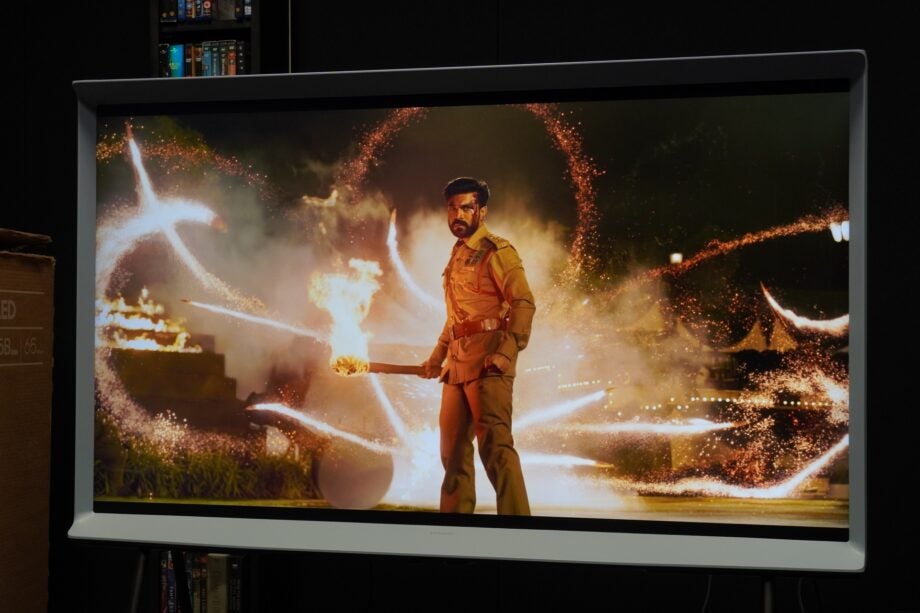

Verdict
For a certain person, The Serif will be the TV of their dreams. Picture performance is enjoyably colourful, and the sound is better than expected. You won’t find a TV that looks as distinctive as this one.
Pros
- Distinctive design
- Colourful picture performance
- Good upscaling
- Solid range of smarts
Cons
- Limited HDR performance
- UI can be sluggish
- Not the most practical TV
Availability
- UKRRP: £799
- USATBC
- EuropeTBC
- CanadaTBC
- AustraliaTBC
Key Features
- QLEDFeatures Samsung’s QLED picture technology
- StandComes with its own stand for freestanding position in a room
Introduction
Samsung is the world’s biggest TV manufacturer for a reason – it sells the most TVs. And part of its success comes down to the fact that it has a TV for everyone – step up The Serif.
The Serif rethinks the notion of TV design, and while it looks odd, it’s won a few awards – including one in 2020 from the International Forum (iF) Design Awards.
It isn’t aimed at the home cinema fan, throwing its lot in with the lifestyle market, and although it isn’t without its faults, it’s better than expected.
Design
- Floor-stand attachment
- Unique aesthetics
- Not the most practical design
Every member of the Trusted Reviews’ team who has seen The Serif has had something to say – some have been slightly bemused; others appreciative. The Serif turns heads and sparks a (brief) conversation, which you could say places this TV within the realm of “art”.
To me, it looks as if it’s been beamed in from the 1950s. Another said it looks like a TV Bang & Olufsen would make. Conjured up by designers Ronan and Erwan Bouroullec, its edges take on the shape of an “I”, noticeable when the TV is viewed from the side. Its proportions are simultaneously chunky and svelte.
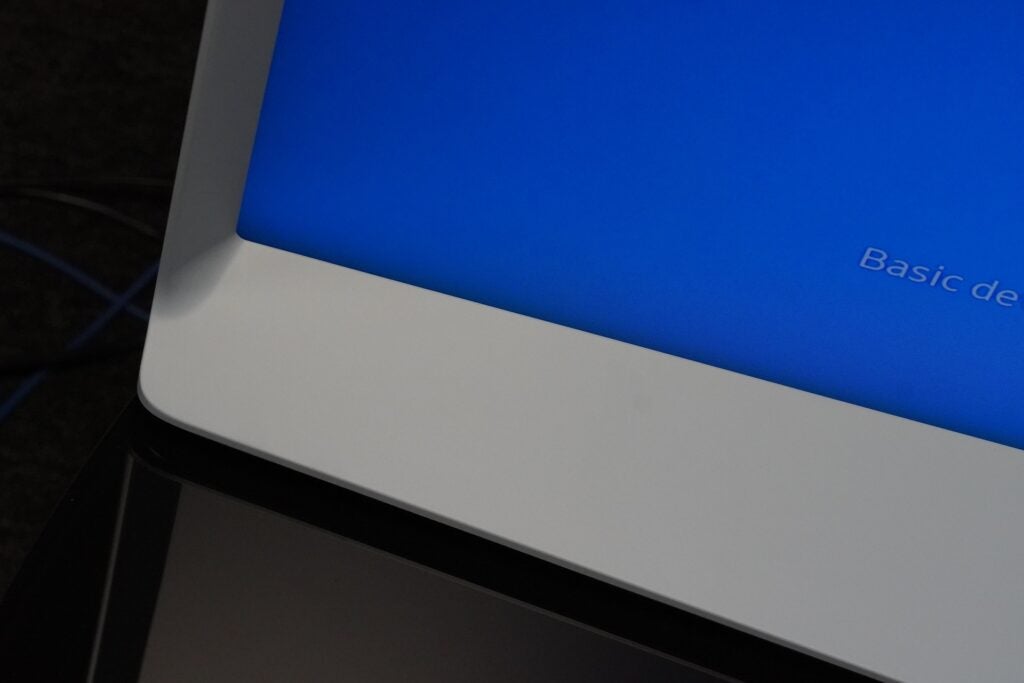
The top surface doubles as a shelf, and the TV can be positioned with or without a stand. Attaching the legs requires two people to flip over the TV and screw them in. No tools are required, so for those who hate assembling TVs, the Serif isn’t too difficult to get up on its feet.
When on its feet the Serif looks both steady and a little ungainly, and moving it requires lifting the entire TV to avoid the feet becoming trapped in the carpet – which can cause a brief moment of concern when it happens as the legs bend.

Connections are in a concealed area revealed by lifting off the back cover, and there’s a gap to filter wires that runs under the TV, which is a considerate bit of cable management. You can also route the cables down the leg with a cable guide that clips on. The Serif doesn’t support any form of wall-mounting – it would take some effort to hoist it upon a wall, if it did.
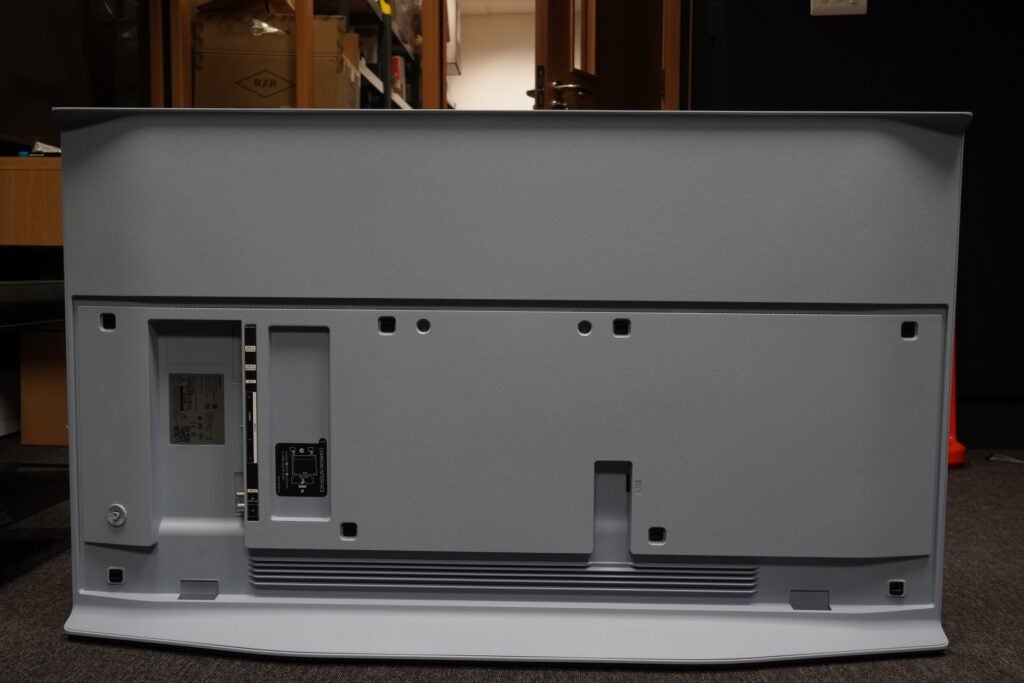
In some ways, the design is impractical. You can’t really add a soundbar; there would be no place to put it, whether the TV is stood up or when it’s without a stand, as the soundbar would block part of the screen/IR receiver.
Adding sources is also problematic unless The Serif is on a conventional stand. A box on top looks weird and having cables trail across the floor feels messy. If there were an optional rack to attach to the legs, that could solve the problem.
The Serif comes in Cotton Blue (this sample) and Cloud White, the former available in sizes 43- to 55-inches and the latter adds a 65-inch size to its options.
Interface
- New, full-screen interface
- Slightly sluggish in response
- Choice of two remotes
The Serif has the latest iteration of Samsung’s Tizen smart interface. It’s gone full screen in the same manner as LG’s webOS, although divides itself into more sections (Search, Ambient, Gaming, Media and Menu). The home hub still has the same row of media apps from 2021 models and earlier, which is likely where most will spend their time.
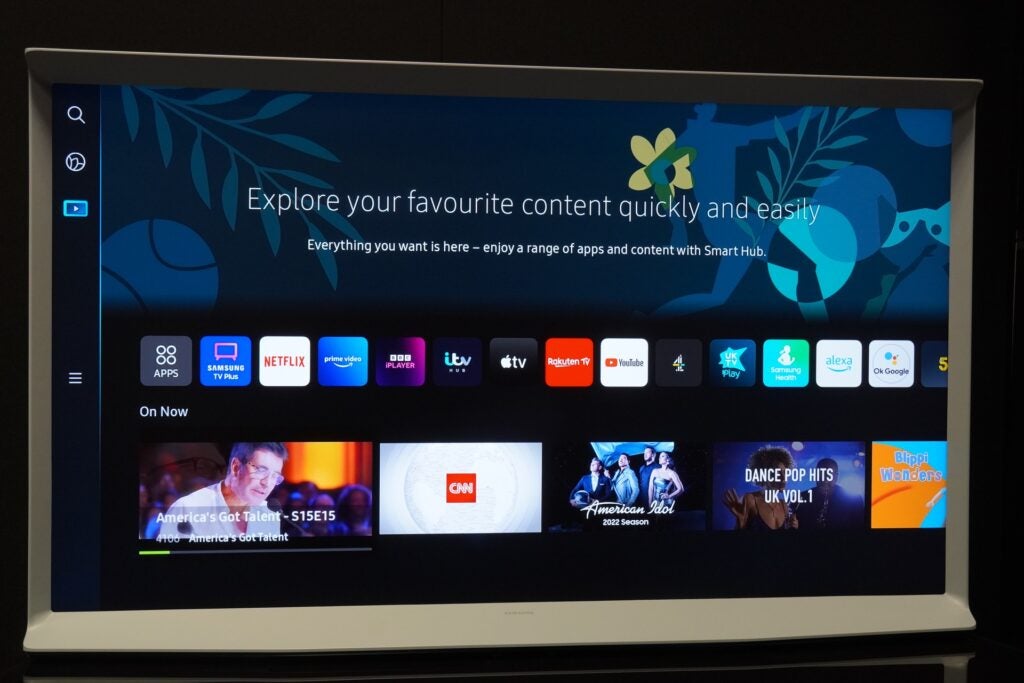
It’s the navigation that slightly bugs me, with a twistier path to reaching some settings where before you could call up the “shelves” and flick through them. An element of convenience and speed is lost in the transition – and, furthermore, the new interface feels sluggish. I’m not irritated by the makeover, but I’m not overly impressed either.

Menu has all the TV settings, connected device list and Multi-View; Media is where streaming apps and related content can be found; Gaming offers access to cloud streaming services; while Ambient is where you can find the creative art designs that act as a wallpaper in the Ambient mode. For the audience that buys this TV, this is the feature for which The Serif was made.

There are two remotes: a slim, smart one with a D-pad for navigation, hot keys for apps such as Disney+ and Samsung TV Plus, and shortcuts to access settings, voice assistants and the Multi-View feature. Then there’s a more standard remote with lots of buttons. The smart remote is the better option.
There are enough apps to sate the thirstiest of streamers, with all the main UK catch-up and on-demand options catered for, alongside the big-hitters in Netflix, Disney+, BT Sport, Prime Video, Spotify and plenty more.
Features
- Samsung TV Plus integration
- Alexa voice assistant support
- Some advanced gaming features
Samsung’s TV Plus is an internet-based content service that’s free to use and has a few exclusive channels such as America’s Got Talent. An as alternative to Freeview Play, there’s plenty of entertainment to take in.

Multi-View offers the ability to watch multiple sources simultaneously, and The Serif supports two screens at once. It only works with Android smartphones when casting content, though.
There’s Amazon and Samsung (Bixby) for voice assistance. Alexa integration isn’t hands-free, instead requiring a press of the mic button on the remote before speaking. Nevertheless, it offers convenience when switching inputs or opening apps. It can take a while for it to jump into action after the TV turns on, which adds to the overall lethargy of the Tizen interface.

The Serif’s smarts are amplified by the SmartThings app, which can be used to operate the TV or talk to other smart products such as Philips Hue or energy monitors. The TV can be set up through SmartThings, a much easier process if you have a Samsung account.
For gaming there’s ALLM (Auto Low Latency Mode), but I must admit that I forgot to write down the input lag. There’s VRR and HDMI 2.1 along with eARC if you want to connect an Atmos soundbar. And there are four HDMI, two USB ports, digital audio output and aerial for terrestrial coverage. Wireless is covered by Wi-Fi, AirPlay 2, NFC and Bluetooth 5.2

Picture Quality
- Colourful performance
- Good upscaling
- HDR performance is limited
The Serif boasts QLED quantum-dot colours, with support for HDR10, HLG and HDR10+ formats. HDR10+ is a dynamic HDR format used by Prime Video and Hulu that optimises supported HDR content in terms of luminance and colour for that screen’s specific capabilities. The Serif needs the assistance, since its brightness is limited, drawing 370 nits on a 10% HDR window. That’s short of the 500 or so nits needed for relatively convincing HDR.
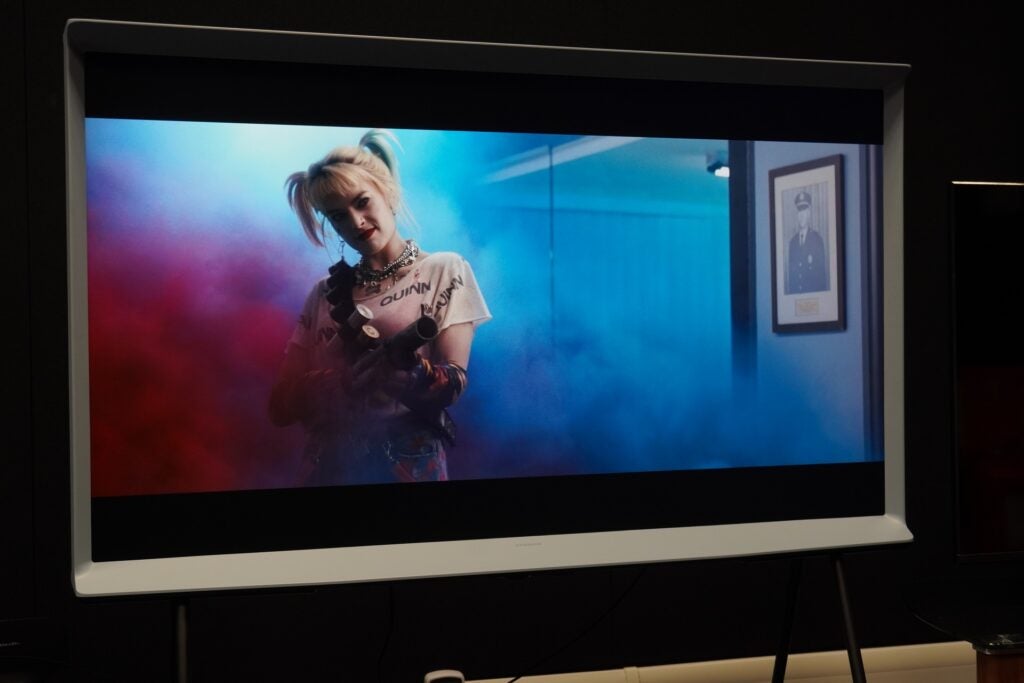
But its colour accuracy (at least in SDR) in Movie mode is impressive out of the box, with few errors noted during measurement. Watching Birds of Prey on Prime Video (in Filmmaker mode) and Bollywood hit RRR on Netflix, The Serif actually boasted punchier, more expressive colours than the QN90A; the tones of yellows, blues and greens gained extra saturation over its Mini LED counterpart.

Its upscaling abilities are strong watching Garden Rescue, with solid levels of sharpness and detail in a HD broadcast. The matte display does introduce a softness to pictures, and that’s noticeable in the IMAX scenes of Tenet, but the reduction in glare helps in bright-room environments.

With 480p standard definition content, the Serif’s upscaling is better than I expected. It’s typically soft but very colourful. The QLED/VA screen provides some extra pep and pomp to the primary and secondary colours in Garden Rescue, while detail is decent in the faces of presenters, as well as the workstations. There’s noise in and around the faces of athletes in the World Athletics Championships – but in upscaling terms, The Serif is a consistent performer.
With motion, programming can look artificial and there’s slight judder and blurriness encountered in its Auto motion clarity setting. Custom is smoother and less distracting if you want motion processing on, but with action scenes (such as the car chase in The Batman) you can see the processing working hard to catch up with the flow of the scene. It’s fine and better than previous incarnations, but could still use finessing.
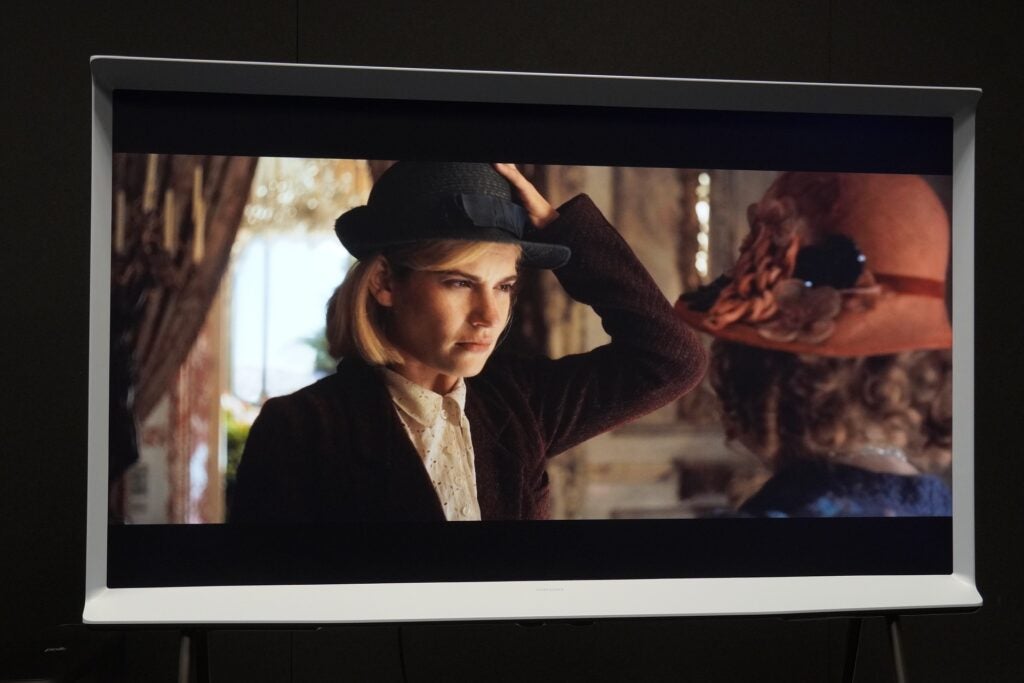
The Serif’s expression of colour is pleasing. Rebecca on Netflix in 4K HDR is presented with yellows that are bright in tone, effervescent greens, and complexions that look richer than they appear on the QN90A. The same applies to Dr Strange 2 on Disney+, with complexions more overt. The blue of America’s Denim jacket and Strange’s cloak is stronger, and white tones appear brighter and convincingly fleshed out.
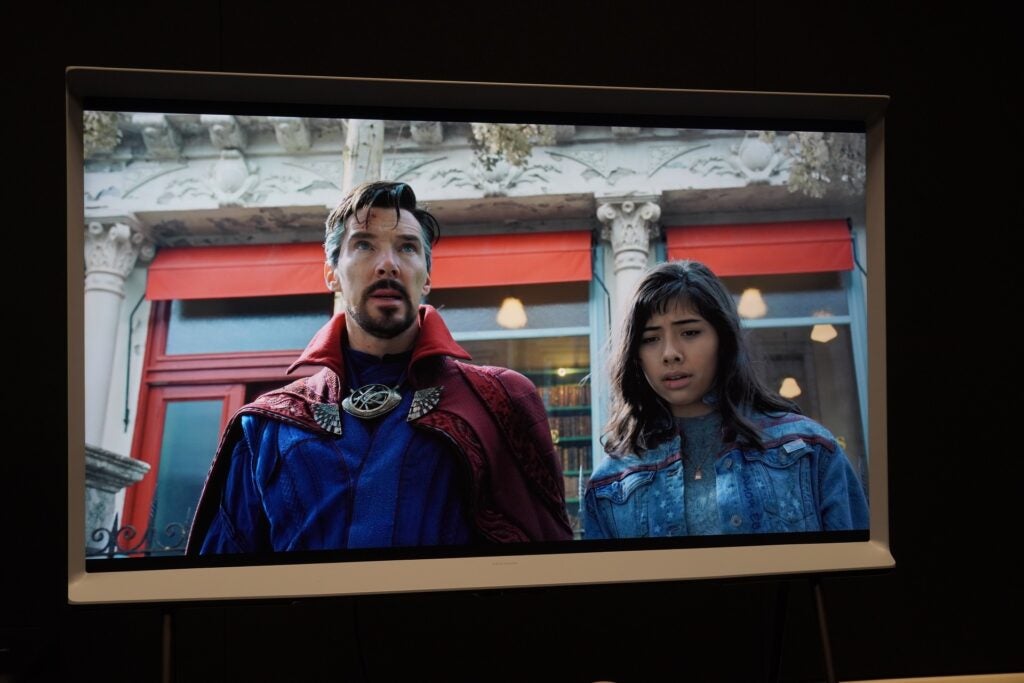
But, in the Movie setting, the complexions of Caucasian actors in Netflix’s The Dig appear to have a yellow tinge that gives them a jaundiced appearance, whereas with America Chavez’s complexion in Dr Strange, or the characters in Netflix’s RRR, they have a more rounded and fuller look. It looks more expressive, but the slightly yellow tinge is noticeable.

The lack of brightness doesn’t produce an electrifying HDR performance, either. The Serif depicts brightness without much pomp, which means contrast isn’t as strong. A lack of detail in the darkest parts of an image produces a less than revealing look, so while black levels in general are solid, detail can be shrouded, with some dark scenes in 4K HDR content looking on the murky side. Contrast Enhancer helps embellish brightness and black levels, but only up to a point.
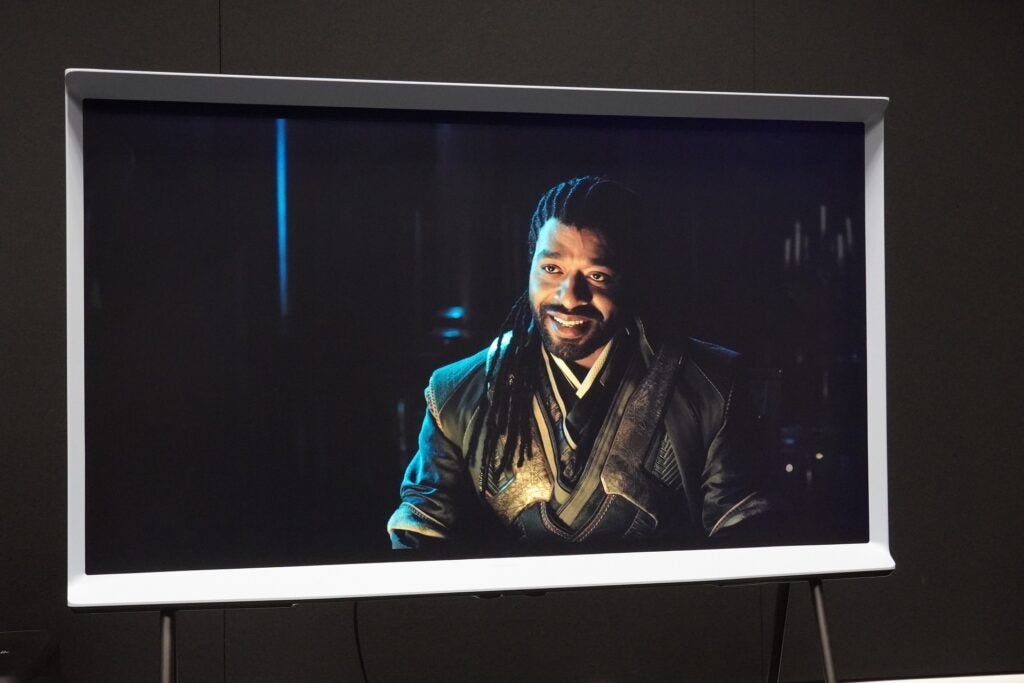
The TV is best suited to being watched in a room with plenty of light, since backlight bleeding appears with letterboxed content in darker rooms as well as characterising black levels as less than black. It’s a solid overall image from this Edge-lit TV, but there’s a ceiling to its HDR performance.
Sound Quality
- Decent bass
- Clear and detailed
- Not the widest soundstage
As I mentioned in the Design section, it’s difficult to add a soundbar to further improve the performance – but without one, the Serif produces a clear, detailed sound with reasonable levels of dynamism that add some excitement to action films.

Bass is modest in size but delivered with decent weight, and sounds match their point of origin on-screen. It isn’t a performance that escapes the confines of the TV’s frame, so it does sound boxed in. However, this complaint could be levelled at most flatscreen TVs.
There’s a choice of two sound modes in Standard and Amplify, and the latter works nicely to boost voices and detail. In the scene between K and Sapper Morton in Blade Runner 2049, there’s a smidge more intensity with Amplify on; but; happily; there’s no distortion.

With music The Serif is surprisingly decent. Raising the volume to 100, there’s no obvious distortion. Playing songs in Spotify Connect, The Serif presents voices clearly and crisply, with instruments detailed and bass, again, decent. There isn’t much dynamism in Elton John’s I’m Still Standing, with The Serif’s boxed-in performance hampering the size of the sound; but for background listening; it’s better than I expected.
Latest deals
Should you buy it?
For the design Can a TV be a piece of art? The Serif certainly believes so. For the design-friendly audience out there, this is a stylish TV to get the conversation started.
If you’re after a more practical TV Suffice to say, not everyone will dig the design, and there’s better picture performance to be found around this price.
Final Thoughts
If Samsung set out to make a unique TV in The Serif, then it’s succeeded. The quantum-dot colour performance enlivens its picture in punchy and expressive ways, although its limited brightness causes problems with HDR content, and the manner in which it portrays some complexions looks a tad inaccurate. Its picture performance is enjoyable in spite of its limitations.
Sound quality is decent for a flatscreen TV, although the revamped smart system could be improved. On the whole, though, The Serif is an enjoyable lifestyle TV. In light of its current RRP (£799) and the target audience, I think it passes the muster.
How we test
We test every televisions we review thoroughly over an extended period of time. We use industry standard tests to compare features properly. We’ll always tell you what we find. We never, ever, accept money to review a product.
Find out more about how we test in our ethics policy.
Tested for a month
Tested with real world use
FAQs
The Serif is designed to stand in a room, while The Frame is primarily intended to be hung on a wall.
Full specs
Sustainability
Trusted Reviews’ holds the fact that global warming is not a myth as a core value and will continuously endeavour to help protect our planet from harm in its business practices.
As part of this mission, whenever we review a product we send the company a series of questions to help us gauge and make transparent the impact the device has on the environment.
We currently haven’t received answers to the questions on this product, but will update this page the moment we do. You can see a detailed breakdown of the questions we ask and why in our sustainability info page.








